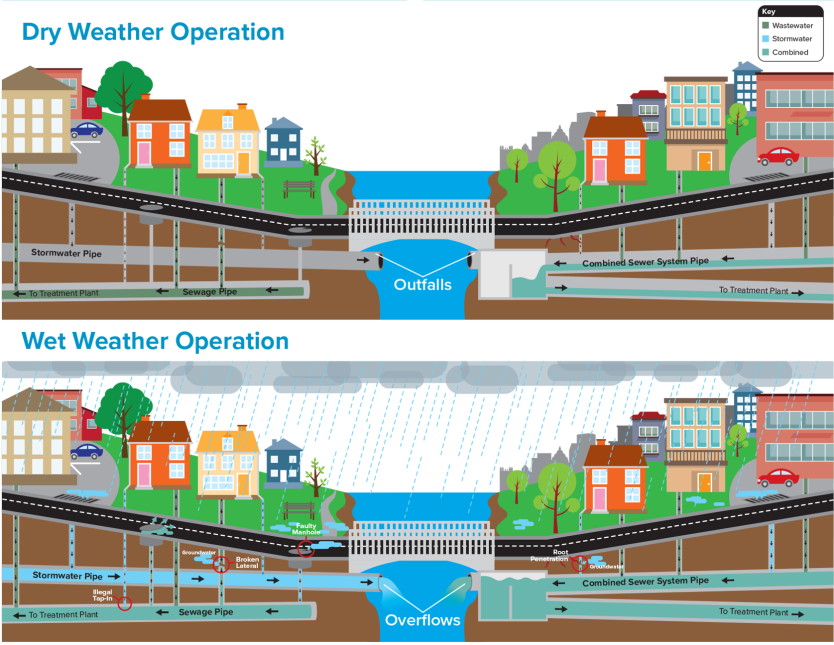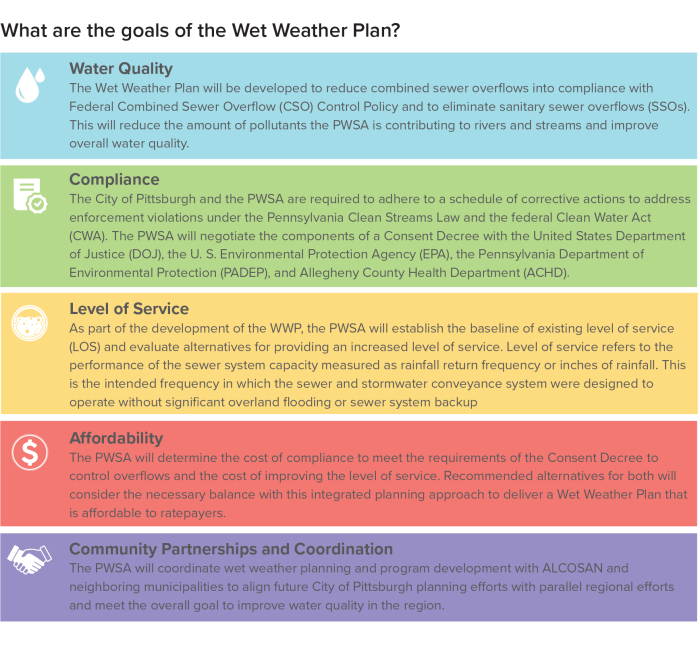What is a Wet Weather Plan?
The historical development of the PWSA sewage system is primarily based on a combined sewage system, where sewage and stormwater flow through the same pipes. Today, during heavy rain or snow events, the pipes become overloaded and discharge the combined sewage and stormwater overflows into our waterways. PWSA is currently developing a Wet Weather Plan (WWP), which will provide a framework for how PWSA will address this important issue.
Roughly 75% of our current system is a combined sewer system and the remaining 25% is a separated storm sewer system. It's important to understand the different ways these two systems manage wastewater and stormwater.
In a separated storm sewer system (MS4), sewage flows through its own pipes and does not get mixed in with stormwater. This significantly reduces the chance that sewage will overflow into waterways. Sewage escaping these systems can potentially occur due to blockages in pipes, illicit stormwater connections and excessive infiltration of groundwater into the sanitary system.
In a combined sewer system, sewage and stormwater flow through the same pipe. In dry weather and smaller wet weather events, sewage is sent to ALCOSAN's regional wastewater treatment plant for environmentally safe processing. In heavy wet weather events, the system can fill up and overflow the mix of sewage and stormwater into our waterways.

Why is this plan needed?
Combined sewer overflows impact water quality of our rivers and streams, which may harm wildlife and impact recreational opportunities. The PWSA’s Wet Weather Plan will serve our mission to protect public health and the environment by reducing our overflows. Overflow reduction will provide environmental and recreational benefits within the City of Pittsburgh, with a strategic focus on how we can target improvements in environmental justice communities. The PWSA’s investments in improving both our combined and sanitary sewer systems align with our core value to provide stewardship to water services for generations to come. Reducing sewer overflows will provide equitable improvements to drinking water sources along the three rivers. The plan will address all these factors and more, and detail solutions for how they can be corrected. The PWSA will work with state and national agencies to ensure that the final plan meets all environmental standards and contributes to a more sustainable future.
Why is the PWSA doing it now?
The PWSA is in the early stages of negotiating a Consent Decree with the Department of Environmental Protection (DEP) and Environmental Protection Agency (EPA). Part of this process requires the development of a wet weather long-term control plan. The PWSA is kicking of this planning effort now and will continue to develop the WWP over the course of the next few years. We will be working with the public and stakeholders throughout the development of the plan to build public understanding. We also are seeking feedback on community priorities and environmental justice considerations for this plan.

How is this different than previous planning efforts?
The current WWP effort will support the PWSA’s needs in entering into a Consent Decree with DEP and EPA and will also evaluate level of service capacity needs throughout our service area. Previous PWSA planning efforts over the past few decades provided foundational data that will support the WWP’s current evaluation including digital mapping and computer models of our sewer collection system. These efforts culminated into the PWSA’s submission of a Wet Weather Feasibility Study (WWFS) to the regulators in 2013. This document, listed below provided work projects being enhanced today, and includes preliminary recommendations for overflow reduction projects that will be evaluated with modern data from the current WWP.
PWSA Wet Weather Feasibility Study, Executive Summary
As part of the PWSA’s 2013 WWFS, we considered Green Stormwater Infrastructure (GSI) and Integrated Watershed Management (IWM) to help with CSO management. Our City-Wide Green First Plan was published as draft in 2016, focusing on CSO reduction impacts and use of GSI throughout the city as stormwater management technology. The evaluation from this study will inform the use of GSI technologies in planning alternatives within the current WWP, along with post-construction performance data collected for several GSI projects that the PWSA has built in recent years.
Citywide Green First Plan
The PWSA’s past efforts were conducted in parallel with ALCOSAN’s Clean Water Plan and the Consent Order wet weather planning efforts of municipalities surrounding the PWSA sewer network. Today, ALCOSAN’s plan has been accepted by EPA, and municipalities have new, ongoing Consent Orders to manage their sewer systems. These major developments will be integrated into the PWSA’s current WWP evaluations and to develop final recommendations for overflow reduction projects. The links below provide more information on the wet weather planning efforts of ALCOSAN and municipal consent orders:
ALCOSAN Clean Water Plan
Municipal Consent Order Information (via 3 Rivers Wet Weather)
